
Hamamatsu is a city located in western Shizuoka Prefecture, Japan. As of 1 September 2023, the city had an estimated population of 780,128 in 340,591 households, making it the prefecture's largest city, and a population density of 501/km2 (1,300/sq mi). The total area of the site is 1,558.06 km2 (601.57 sq mi).
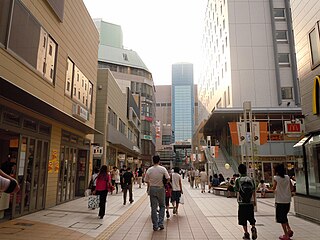
Yokkaichi is a city located in Mie Prefecture, Japan. As of 1 August 2021, the city had an estimated population of 310,259 in 142162 households and a population density of 1500 persons per km2. The total area of the city is 206.44 square kilometres (79.71 sq mi).

Suzuka is a city in Mie Prefecture, Japan. As of 31 July 2020, the city had an estimated population of 197,977 in 87,680 households and a population density of 1000 persons per km². The total area of the city is 194.46 square kilometres.

Ōta is a city located in Gunma Prefecture, Japan. As of 31 August 2020, the city had an estimated population of 224,358 in 109,541 households, and a population density of 1300 persons per km2. The total area of the city is 60.97 square kilometres (23.54 sq mi).

Aichi Prefecture is a prefecture of Japan located in the Chūbu region of Honshū. Aichi Prefecture has a population of 7,552,873 and a geographic area of 5,172.92 square kilometres (1,997.28 sq mi) with a population density of 1,460 inhabitants per square kilometre (3,800/sq mi). Aichi Prefecture borders Mie Prefecture to the west, Gifu Prefecture and Nagano Prefecture to the north, and Shizuoka Prefecture to the east.
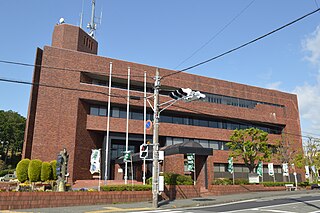
Kikugawa is a city located in the western portion of Shizuoka Prefecture, Japan. As of 28 February 2023, the city had an estimated population of 47,714 in 18,775 households, and a population density of 510 persons per km². The total area of the city is 94.19 square kilometres (36.37 sq mi). The city is known for production of green tea. The city's slogan is "Green for the Next Generation".
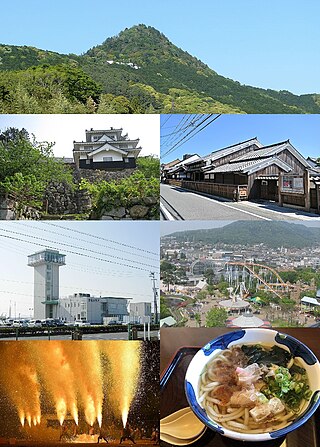
Toyohashi is a city in Aichi Prefecture, Japan. As of 1 December 2019, the city had an estimated population of 377,453 in 160,516 households and a population density of 1,400 persons per km2. The total area of the city was 261.86 square kilometres (101.10 sq mi). By area, Toyohashi was Aichi Prefecture's second-largest city until March 31, 2005 when it was surpassed by the city of Toyota, which had merged with six peripheral municipalities.

Ōizumi is a town located in Gunma Prefecture, Japan. As of 31 August 2020, the town had an estimated population of 41,918 in 19,773 households, and a population density of 2300 persons per km². The total area of the town is 18.03 km2 (6.96 sq mi). Approximately 20 percent of the total population are foreign citizens, mostly Japanese Brazilians, who work at many factories in the town. Since 1990, Japanese descendants from foreign countries have been permitted to stay in Japan freely. It is estimated that 15 percent of the population speak Portuguese as their native language, and as of 2007, Ōizumi has the highest concentration of Brazilians of any city in Japan. More recently, Nepalese and other Asians have begun settling in the town.
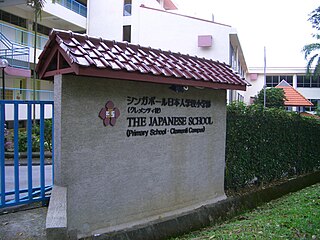
Nihonjin gakkō, also called Japanese school, is a full-day school outside Japan intended primarily for Japanese citizens living abroad. It is an expatriate school designed for children whose parents are working on diplomatic, business, or education missions overseas and have plans to repatriate to Japan.
There is a significant community of Brazilians in Japan, consisting largely but not exclusively of Brazilians of Japanese descent. Brazilians with Japanese descent are known as Nikkei Brazilians. They constitute the largest number of native Portuguese speakers in Asia, greater than those of formerly Portuguese East Timor, Macao and Goa combined. Likewise, Brazil maintains its status as home to the largest Japanese community outside Japan.
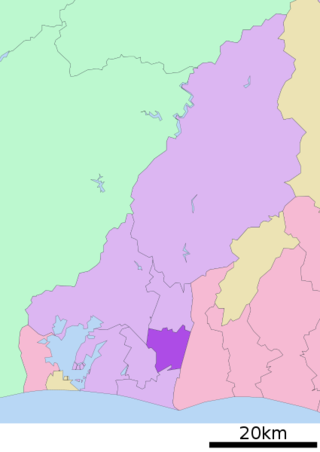
Higashi-ku is one of seven wards of Hamamatsu, Shizuoka, Japan, located in the east-central part of the city. It is the second smallest of the seven wards of Hamamatsu in terms of area, after Naka-ku. It is bordered by Hamakita-ku, Kita-ku, Minami-ku, and Naka-ku.
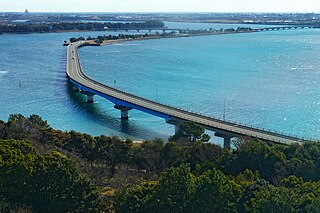
Nishi-ku is one of seven wards of Hamamatsu, Shizuoka, Japan, located in the southwest corner of the city. It is bordered by Naka-ku, Kita-ku, Minami-ku, and the city of Kosai. The 3rd largest ward of Hamamatsu in terms of area, much of the ward is still rural, with farms and rice fields.
Japanese School of Manaus is a Japanese international school in Manaus, Brazil. The school, which has students between the ages of 6 and 15, has 15 Brazilian Japanese students and 12 Japanese students as of 2013. It was established to educate children of Japanese businesspersons working in the Manaus area.
Associação Civil de Divulgação Cultural e Educacional Japonesa do Rio de Janeiro is a Japanese international school in Cosme Velho, Rio de Janeiro, Brazil.

Hamamatsu Municipal Senior High School is a senior high school in Hamamatsu, Japan, operated by the city government.

Instituto Educacional Centro Nippo Brasileiro is a Brazilian school in Oizumi, Gunma which serves kindergarten through 12th grade.
Colegio Hispano Americano de Gunma is a Peruvian international school in Isesaki, Gunma, Japan. A part of the Centro de Desarrollo Hispano Americano, it serves levels six months through preschool, primary school and secondary school. It was established in 1999.
C.E.P. Mundo de Alegría is a Peruvian international school in Nishi-ku, Hamamatsu, Japan. The school, which has primary and secondary levels, uses Spanish as the medium of instruction. In 2013 the Embassy of Peru celebrated the school's 10 year anniversary.

Asociación Academia de Cultura Japonesa is a Japanese international school in Surco, Lima, Peru. It is under the Asociación Academia de Cultura Japonesa, which has the same Spanish name but a different Japanese name. It serves elementary and junior high school levels.
Escola Alegria de Saber is a network of Brazilian international schools in Japan. It has campuses in Aichi, Gunma, Mie, and Shizuoka prefectures. The campuses, which have about 2,000 students as of 2015, serve the ensino fundamental and ensino médio levels.













